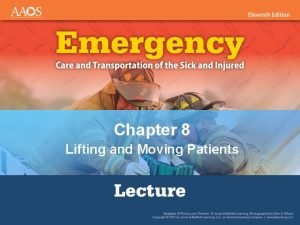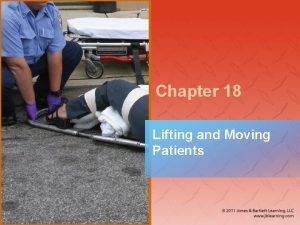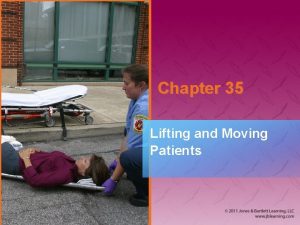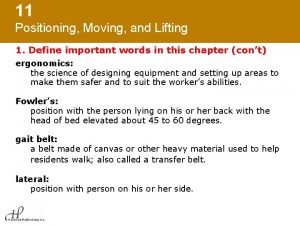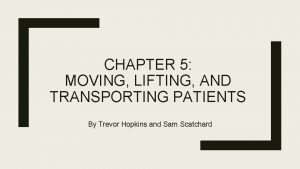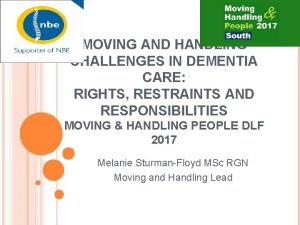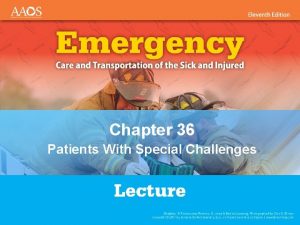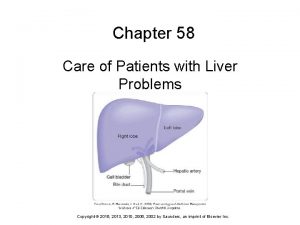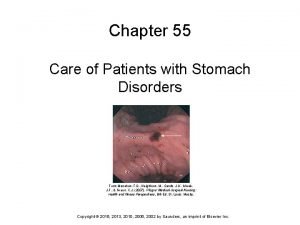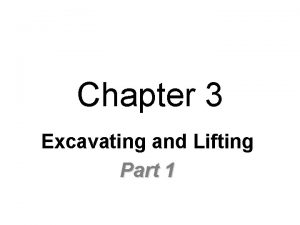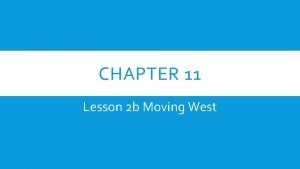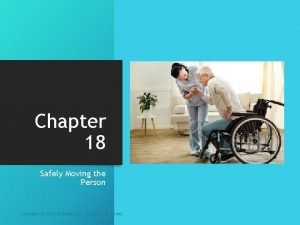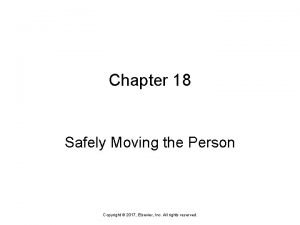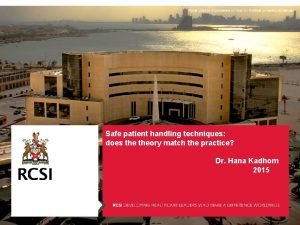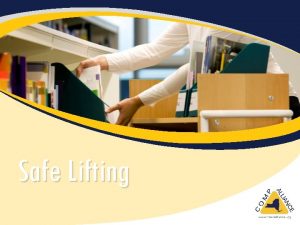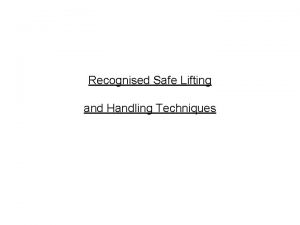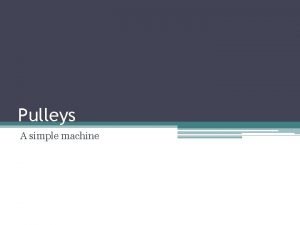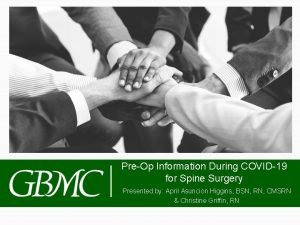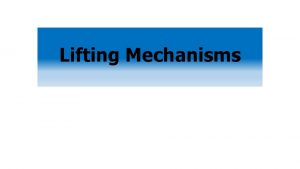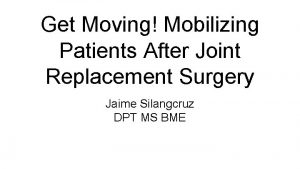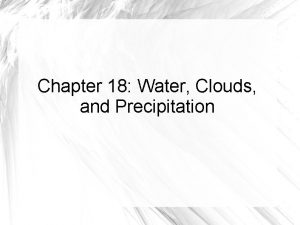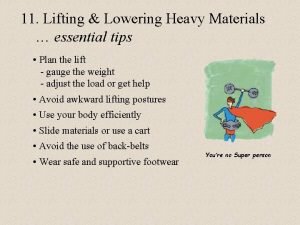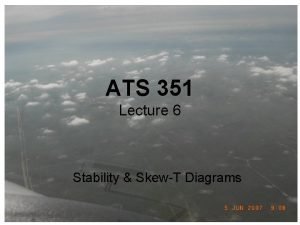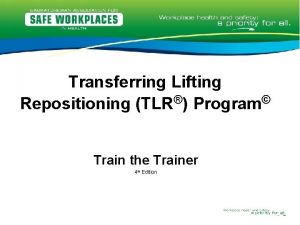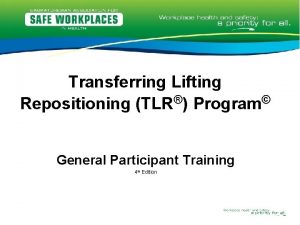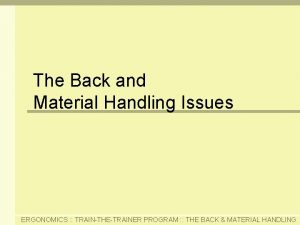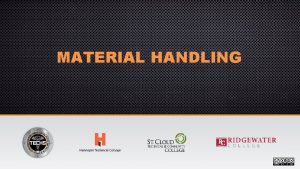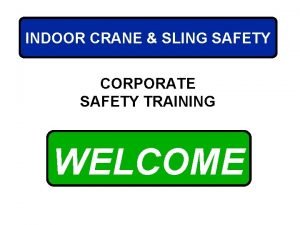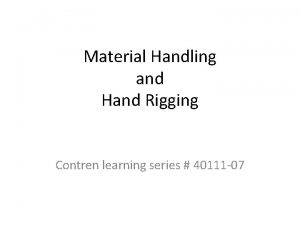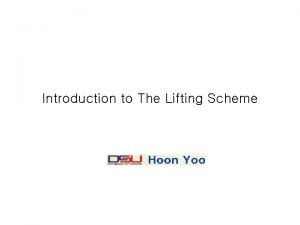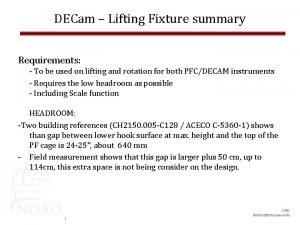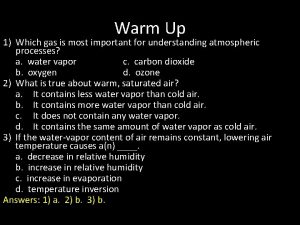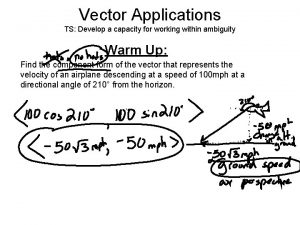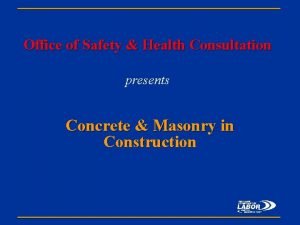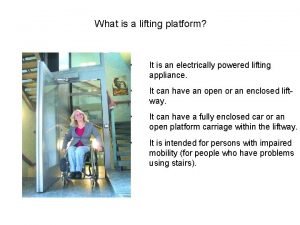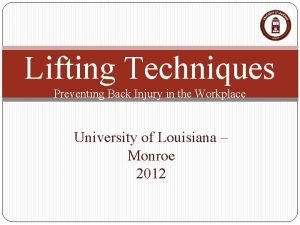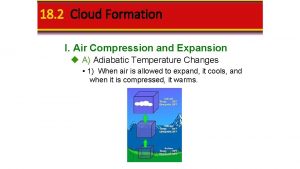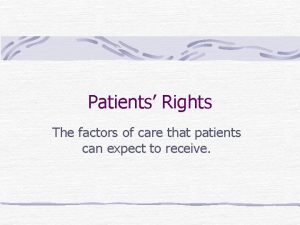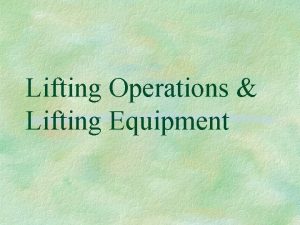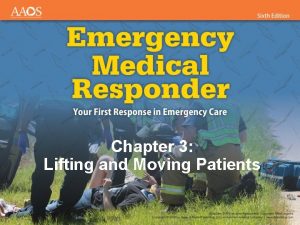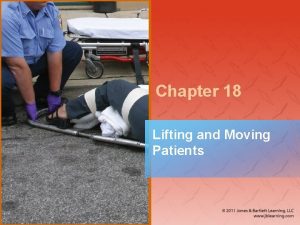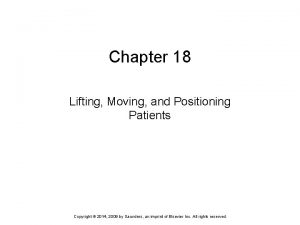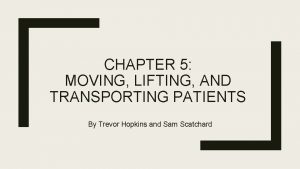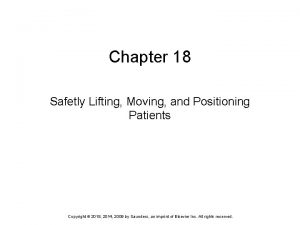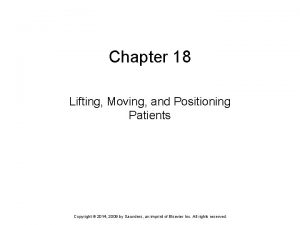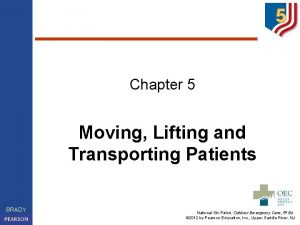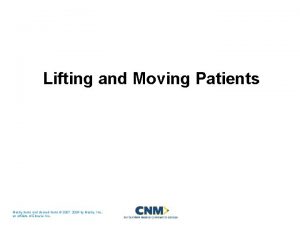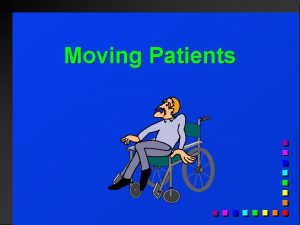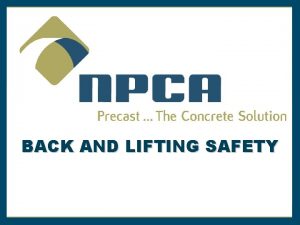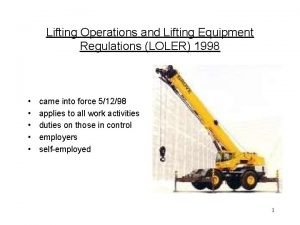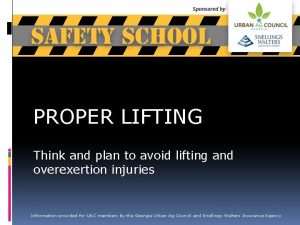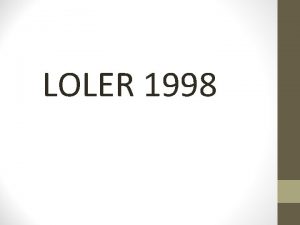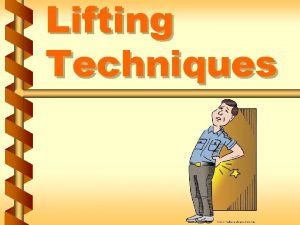Chapter 8 Lifting and Moving Patients Introduction In










































































- Slides: 74

Chapter 8 Lifting and Moving Patients

Introduction • In the course of a call, you will have to move patients to provide emergency medical care and transport. • To move patients without injury, you need to learn the proper techniques. • Knowledge of proper body mechanics and a power grip is important.

The Wheeled Ambulance Stretcher (1 of 5) • Wheeled ambulance stretcher – Also called an ambulance stretcher or gurney – Most commonly used device © Jones and Bartlett Learning.

The Wheeled Ambulance Stretcher (2 of 5) • The wheeled ambulance stretcher weighs 40– 145 lb. – Generally not taken up or down stairs or where the patient must be carried for any significant distance

The Wheeled Ambulance Stretcher (3 of 5) • Moving a patient by rolling, using a stretcher or other wheeled device, is preferred when the situation allows and helps prevent injuries from carrying. • A number of models are available. • Before going on a call, familiarize yourself with the specific features of the stretcher your ambulance carries.

The Wheeled Ambulance Stretcher (4 of 5) • General features – Head end and foot end – Strong metal frame to which all other parts are attached – Hinges at center allow for elevation of head/back. – Guardrails prevent the patient from rolling out.

The Wheeled Ambulance Stretcher (5 of 5) • General features (cont’d) – Undercarriage frame allows adjustment to any height. – Mattress must be fluid resistant. – The patient is secured with straps. • Help protect the patient from further injury

Backboards (1 of 2) • Long, flat, and made of rigid rectangular material (mostly plastic) • Used to carry and immobilize patients with suspected spinal injury or other trauma © Jones & Bartlett Learning. Courtesy of MIEMSS.

Backboards (2 of 2) • Commonly used for patients found lying down • Used to move patients out of awkward places • 6– 7 feet long • Holes serve as handles and as a place to secure straps.

Moving and Positioning the Patient (1 of 2) • When you move a patient, take care that injury does not occur: – To your team – To the patient • Patient lifting and moving are technical skills that require repeated training and practice.

Moving and Positioning the Patient (2 of 2) • Many EMTs are injured lifting and moving patients. • Using proper body mechanics and maintaining physical fitness greatly reduce the chance of injury.

Body Mechanics (1 of 9) • Anatomy review © Jones and Bartlett Learning.

Body Mechanics (2 of 9) • Lifting position – Shoulder girdle should be aligned over pelvis – Hands should be held close to legs – Force then goes essentially straight down spinal column – Very little strain occurs

Body Mechanics (3 of 9) • This is the correct way to lift. © Jones & Bartlett Learning. Courtesy of MIEMSS.

Body Mechanics (4 of 9) • You may injure your back: – If you lift while leaning forward – If you lift with your back straight but bent significantly forward at the hips

Body Mechanics (5 of 9) • This is an incorrect method of lifting. © Jones & Bartlett Learning. Courtesy of MIEMSS.

Body Mechanics (6 of 9) • Lifting technique – Legs should be spread about 15 inches apart (shoulder width). – Place feet so the center of gravity is balanced. – With your back held upright, bring your upper body down by bending the legs. – Grasp the patient/stretcher.

Body Mechanics (7 of 9) • Lifting technique (cont’d) – Lift the patient by raising your upper body and arms and straightening your legs until standing. – Keep the weight close to your body. – Keep your arms the same distance apart.

Body Mechanics (8 of 9) • The power grip gets maximum force from the hands. – Palms up – Hands about 10 inches apart – All fingers at same angle – Fully support handle on curved palm

Body Mechanics (9 of 9) © Jones & Bartlett Learning. Courtesy of MIEMSS. • When directly lifting a patient, tightly grip the patient in a place and manner that will ensure that you will not lose your grasp on the patient.

Principles of Safe Reaching and Pulling (1 of 6) • Body drag – The same body mechanics and principles apply to moving, lifting, and carrying a patient. – Keep your back locked by tightening your abdominal muscles. – Kneel. – Extend your arms no more than 15– 20 inches in front of you. – Alternate between pulling the patient by flexing your arms and repositioning yourself.

Principles of Safe Reaching and Pulling (2 of 6) © Jones & Bartlett Learning.

Principles of Safe Reaching and Pulling (3 of 6) • To drag a patient across a bed: – Kneel on the bed to avoid reaching beyond the recommended distance. – Drag the patient to within 15– 20 inches. – Complete the drag while standing at the side of the bed. – Use the sheet or blanket under the patient rather than dragging the patient by his or her clothing.

Principles of Safe Reaching and Pulling (4 of 6) • In the hospital, transfer the patient from the stretcher to a bed with a body drag. – The stretcher should be the same height or slightly higher than the bed. – You and a partner should kneel on the bed and drag in increments.

Principles of Safe Reaching and Pulling (5 of 6) • Log roll the patient onto his or her side to place a patient on a backboard. © Jones & Bartlett Learning. Courtesy of MIEMSS.

Principles of Safe Reaching and Pulling (6 of 6) • Log rolling (cont’d) – Kneel as close to the patient’s side as possible. – Keep your back straight and lean solely from the hips. – Roll the patient without stopping until the patient is resting on his or her side and braced against your thighs. – Pulling toward you allows your legs to prevent the patient from rolling over completely.

Principles of Safe Lifting and Carrying (1 of 11) • Whenever possible, use a device that can be rolled. • When a wheeled device is not available, make sure that you understand follow the guidelines for carrying a patient on a stretcher.

Principles of Safe Lifting and Carrying (2 of 11) • Patient weight – Estimate the patient’s weight before lifting. • Adults often weigh 120– 220 lb. • Two EMTs should be able to safely lift this weight. – Try to use four providers to lift when possible. • More stability • Requires less strength

Principles of Safe Lifting and Carrying (3 of 11) • Patient weight (cont’d) – Do not attempt to lift a patient who weighs more than 250 lb with fewer than four providers. – Know the weight limitations of the equipment and how to handle patients who exceed the weight limitations.

Principles of Safe Lifting and Carrying (4 of 11) • Lifting and carrying a patient on a backboard or stretcher – More of the patient’s weight rests on the head half of the device than on the foot half. – The diamond carry and the one-handed carry use one EMT at the head and the foot, and one on each side of the patient’s torso.

Principles of Safe Lifting and Carrying (5 of 11) © Jones & Bartlett Learning. Courtesy of MIEMSS.

Principles of Safe Lifting and Carrying (6 of 11) • Lifting and carrying a patient on a backboard or stretcher (cont’d) – Use four providers—one provider at each corner of the stretcher to provide an even lift. – When rolling the wheeled ambulance stretcher, make sure that it is in the fully elevated position. – Your partner should control the head end assist you by pushing with his or her arms held with the elbows bent.

Principles of Safe Lifting and Carrying (7 of 11) • Moving a patient with a stair chair – Use a stair chair to carry a conscious patient up or down a flight of stairs – This lightweight, wheeled folding chair has a molded seat, adjustable safety straps, and foldout handles at both the head and feet. © Jones & Bartlett Learning.

Principles of Safe Lifting and Carrying (8 of 11) • Moving a patient on stairs with a stretcher – A backboard should be used instead for a patient: • Who is unresponsive • Who must be moved in supine position • Who must be immobilized

Principles of Safe Lifting and Carrying (9 of 11) • Moving a patient on stairs with a stretcher (cont’d) – Carry the patient on the backboard down to the prepared stretcher. – Place the strongest EMTs at the head and foot ends, with the taller person at the foot end. – Place both the backboard and the patient on the stretcher; secure both to the stretcher with additional straps.

Principles of Safe Lifting and Carrying (10 of 11) • Loading a wheeled stretcher into an ambulance – Ensure the frame is held firmly between two hands so it does not tip. © Jones & Bartlett Learning.

Principles of Safe Lifting and Carrying (11 of 11) • Loading a wheeled stretcher into an ambulance (cont’d) – Newer models are self-loading, allowing you to push the stretcher into the ambulance. – Other models need to be lowered and lifted to the height of the floor of ambulance. – Clamps in the ambulance hold the stretcher in place.

Directions and Commands (1 of 3) • Team actions must be coordinated. • Team leader – Indicates where each team member should be – Rapidly describes the sequence of steps to perform before lifting

Directions and Commands (2 of 3) • Preparatory commands are used. • Example: – Team leader says, “All ready to stop, ” to get team’s attention. – Team leader says, “Stop!” in a louder voice. • Countdowns are also used.

Directions and Commands (3 of 3) • Carefully plan ahead. • Select the methods that will involve the least amount of lifting and carrying. – Consider whethere is an option that will cause less strain.

Emergency Moves (1 of 5) • Use when there is potential for danger – Fire, explosives, hazardous materials • Use when you cannot properly assess the patient or provide immediate care because of the patient’s location or position

Emergency Moves (2 of 5) • If you are alone, use a drag to pull the patient along the long axis of the body. • Use techniques to help prevent aggravation of patient spinal injury. – Clothes drag – Blanket drag – Arm-to-arm drag

Emergency Moves (3 of 5) © Jones & Bartlett Learning. Courtesy of MIEMSS.

Emergency Moves (4 of 5) • To remove an unconscious patient from a vehicle alone: – Move the patient’s legs clear of the pedals. – Rotate the patient so the back is toward the open car door. – Place your arms through the armpits and support the head against your body. – Drag the patient from the seat to a safe location.

Emergency Moves (5 of 5) © Jones & Bartlett Learning. Courtesy of MIEMSS.

Urgent Moves (1 of 2) • Necessary to move patient: – With altered level of consciousness – With inadequate ventilation – In shock – In extreme weather conditions • Rapid extrication technique requires a team of knowledgeable EMTs.

Urgent Moves (2 of 2) • Rapid extrication technique should be used only if urgency exists. • The patient can be moved within 1 minute. • This techniques increases the risk of damage if the patient has a spinal injury. • Look at all options before using an urgent move.

Nonurgent Moves (1 of 4) • Used when both the scene and the patient are stable • Carefully plan how to move the patient. • Team leader should plan the move. – Personnel – Obstacles identified – Equipment – Procedure and path

Nonurgent Moves (2 of 4) • Choose between: – Direct ground lift • For patients with no suspected spinal injury who are supine • Patients who need to be carried over some distance • EMTs stand side by side to lift and carry the patients.

Nonurgent Moves (3 of 4) – Extremity lift • For those patients with no suspected spinal injury who are supine or sitting • Helpful when the patient is in a small space • One EMT is at the patient’s head and the other at the patient’s feet. • Coordinate moves verbally.

Nonurgent Moves (4 of 4) • Transfer moves – Direct carry • Move supine patient from bed to stretcher using a direct carry method – Draw sheet method • Move patient from bed to stretcher using a sheet or blanket – Scoop stretcher

Geriatrics (1 of 2) • Most patients transported by EMS are geriatric patients. • Skeletal changes may cause brittle bones, rigidity, and spinal curvatures that present special challenges. • Allay the patient’s fears with a sympathetic and compassionate approach.

Geriatrics (2 of 2) © Dr. P. Marazzi/Photo Researchers, Inc. Kyphosis © Dr. P. Marazzi/Photo Researchers, Inc. Spondylosis

Bariatrics (1 of 2) • Refers to management of obesity • 76 million US adults are obese. – 30– 40% of adults are obese. – Approximately 17% of children are obese. • Back injuries account for the largest number of missed days of work.

Bariatrics (2 of 2) • Stretchers and equipment are being produced with higher capacities. – Does not address danger to users of that equipment – Mechanical ambulance lifts are uncommon in the United States.

Additional Patient-Moving Equipment (1 of 13) • Bariatric stretchers – Specialized for overweight or obese patients – Wider wheelbase for increased stability Courtesy of Stryker Medical, a division of Stryker Corporation.

Additional Patient-Moving Equipment (2 of 13) • Bariatric stretchers (cont’d) – Some have a tow package with a winch. – Rated to hold 850– 900 lb • Regular stretcher rated for 650 lb maximum

Additional Patient-Moving Equipment (3 of 13) • Pneumatic and electronic-powered wheeled stretchers Courtesy of Stryker Medical, a division of Stryker Corporation. – Battery operated with electronic controls to raise/lower the undercarriage • Increases the weight of the stretcher • Hazardous in uneven terrain

Additional Patient-Moving Equipment (4 of 13) • Portable/folding stretchers – Strong, rectangular tubular metal frame with fabric stretched across it © Steve Gorton/Getty Images.

Additional Patient-Moving Equipment (5 of 13) • Portable/folding stretchers (cont’d) – Some models have two wheels. – Some can be folded in half. – Used in difficult-to-reach areas – Weigh less then wheeled stretchers

Additional Patient-Moving Equipment (6 of 13) • Flexible stretchers – Excellent for storage and carrying – Conform around a patient’s sides – Useful for confined spaces – Uncomfortable, but provide support and immobilization © American Academy of Orthopaedic Surgeons.

Additional Patient-Moving Equipment (7 of 13) • Short backboards – Used to immobilize seated patients • Example: the KED vest-type device © Jones & Bartlett Learning. Courtesy of MIEMSS.

Additional Patient-Moving Equipment (8 of 13) • Vacuum mattresses – Alternative to backboards for immobilizing geriatric and pediatric patients – Air is removed from the device, allowing it to mold around the patient. – Provides immobilization, comfort, and thermal insulation

Additional Patient-Moving Equipment (9 of 13) • Basket stretchers – Rigid stretcher – Also called a Stokes litter © Jones & Bartlett Learning. Courtesy of MIEMSS. – Used for patient removal in remote locations, including in water rescues and technical rope rescues

Additional Patient-Moving Equipment (10 of 13) • Basket stretchers (cont’d) – If the patient has a spinal injury, secure the patient to the backboard and place it inside the basket stretcher to carry the patient out of the location. – When you return to ambulance, lift the backboard out of basket stretcher and place it on the wheeled stretcher.

Additional Patient-Moving Equipment (11 of 13) • Scoop stretchers – Also called orthopaedic stretcher © Jones & Bartlett Learning. Courtesy of MIEMSS.

Additional Patient-Moving Equipment (12 of 13) • Scoop stretchers (cont’d) – Splits into two or four pieces • Pieces fit around patient who is lying on flat surface, and then reconnect – Both sides of the patient must be accessible. – The patient must be stabilized and secured on a scoop stretcher.

Additional Patient-Moving Equipment (13 of 13) • Neonatal isolette – Sometimes called an incubator – Neonates cannot be transported on a wheeled stretcher. – The isolette keeps the neonate warm, and protects the child from noise, draft, infection, and excess handling. – The isolette may be secured to a wheeled ambulance stretcher or freestanding.

Decontamination • Decontaminate equipment after use. – For your safety – For the safety of the crew – For the safety of the patient – To prevent the spread of disease

Patient Positioning (1 of 2) • Proper position depends on the chief complaint. – Patients with head injury, shock, spinal injury, pregnancy, and obese patients need special lifting and moving techniques. – A patient reporting chest pain or respiratory distress should be placed in a position of comfort—typically a Fowler or semi-Fowler position. – Patients in shock should be placed supine.

Patient Positioning (2 of 2) • Proper position (cont’d) – Patients in late stages of pregnancy should be positioned and transported on their left side. – An unresponsive patient with no suspected spinal injury should be placed in the recovery position. – A patient who is nauseated or vomiting should be transported in a position of comfort. – Obese patients should be positioned the same as other patients with a similar condition.

Medical Restraints (1 of 2) • Evaluate for correctible causes of combativeness. – Head injury, hypoxia, hypoglycemia • Follow local protocols. • Restraint requires five personnel. • Restrain the patient in a supine position. – Positional asphyxia may develop in the prone position.

Medical Restraints (2 of 2) • Apply a restraint to each extremity. • Assess ABCs, mental status, and distal circulation after restraints are applied. © Jones & Bartlett Learning. Courtesy of MIEMSS. • Document all information.

Personnel Considerations • Questions to ask before moving patient: – Am I physically strong enough to lift/move this patient? – Is there adequate room to get the proper stance to lift the patient? – Do I need additional personnel for lifting assistance? • Injured EMTs cannot help anyone.
 Chapter 8 lifting and moving patients
Chapter 8 lifting and moving patients Lifting and moving patients
Lifting and moving patients Backboard strapping techniques
Backboard strapping techniques Whenever you grasp a stretcher or backboard
Whenever you grasp a stretcher or backboard Transfer belt definition
Transfer belt definition Lifting tackles
Lifting tackles Semi fowlers position
Semi fowlers position Moving and handling dementia patients
Moving and handling dementia patients Patients with special challenges
Patients with special challenges Chapter 58 care of patients with liver problems
Chapter 58 care of patients with liver problems Chapter 55 care of patients with stomach disorders
Chapter 55 care of patients with stomach disorders Chapter 9 expanding markets and moving west
Chapter 9 expanding markets and moving west Chapter 9 expanding markets and moving west
Chapter 9 expanding markets and moving west Chapter 9 expanding markets and moving west
Chapter 9 expanding markets and moving west Mechanical drives and lifting machines n2
Mechanical drives and lifting machines n2 Excavating and lifting equipment
Excavating and lifting equipment Patient rights and responsibilities nabh
Patient rights and responsibilities nabh Safe staffing ratios: benefiting nurses and patients
Safe staffing ratios: benefiting nurses and patients Medicare improvements for patients and providers act
Medicare improvements for patients and providers act Chapter 30 section 1 moving toward conflict
Chapter 30 section 1 moving toward conflict Chapter 22 section 1 moving toward conflict
Chapter 22 section 1 moving toward conflict The move west continues
The move west continues Chapter 19 safely transferring the person
Chapter 19 safely transferring the person Chapter 18 safely moving the person
Chapter 18 safely moving the person Chapter 18 safely moving the person
Chapter 18 safely moving the person Tell something about the multimodal text big ed mona
Tell something about the multimodal text big ed mona Orthodox lifting in nursing
Orthodox lifting in nursing Ergonomic lifting techniques
Ergonomic lifting techniques Kinetic lifting techniques
Kinetic lifting techniques Does a single pulley reduce force
Does a single pulley reduce force Spinal precautions blt
Spinal precautions blt Vex lifting mechanisms
Vex lifting mechanisms Frontal lifting
Frontal lifting Frontal lifting
Frontal lifting Knee replacement surgery cost
Knee replacement surgery cost What's happening in the picture
What's happening in the picture Doctrine of constructive notice
Doctrine of constructive notice Frontal lifting
Frontal lifting Cumulus clouds
Cumulus clouds Lifting/lowering
Lifting/lowering Precipitatoin
Precipitatoin Imbalances in earth’s heat energy help to create weather.
Imbalances in earth’s heat energy help to create weather. Chandelier lifting operations
Chandelier lifting operations Cebeo filialen
Cebeo filialen Absolutely unstable air
Absolutely unstable air Tlr participant worksheet answers
Tlr participant worksheet answers Tlr certification saskatchewan
Tlr certification saskatchewan Wisha lifting calculator
Wisha lifting calculator Smart lifting technique
Smart lifting technique Sling crane safety
Sling crane safety To gently combine two mixtures
To gently combine two mixtures Frontal wedging definition
Frontal wedging definition Safe lifting zone
Safe lifting zone Orographic lifting definition
Orographic lifting definition Answerd
Answerd Lifting device
Lifting device Lifting
Lifting Types of fingerprints
Types of fingerprints Lifting slings
Lifting slings Rigid and non rigid dams
Rigid and non rigid dams Localized convective lifting
Localized convective lifting The cranes shown in the figure are lifting an object
The cranes shown in the figure are lifting an object Our father all of heaven roars your name lyrics
Our father all of heaven roars your name lyrics Limited access zone
Limited access zone Liftingwithlola
Liftingwithlola What is a lifting platform
What is a lifting platform Lifting injury
Lifting injury Kinetic lifting principle
Kinetic lifting principle Iodine fuming definition forensics
Iodine fuming definition forensics Kinetic lifting
Kinetic lifting Localized convective lifting
Localized convective lifting Life expectancy of sickle cell patients
Life expectancy of sickle cell patients Bed positions for nursing
Bed positions for nursing Perimylolysis
Perimylolysis Factors of care that patients can expect to receive
Factors of care that patients can expect to receive
